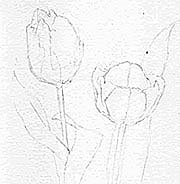|
|
|
| Welcome to Arcadia: Demos/Belcanto Tulip, page 2 |

|
Belcanto Tulip, page 2 |
|
Home About Classes Galleries Exhibits Demos What? Links Site Map
|
|
|
Once I've established the composition, I need to sketch it onto my "ground"; in this case, a small sheet of 140 lb. Arches, hot press. ("Hot press" paper is smoother than "cold press".) I use a soft drawing pencil to sketch with, usually a B2 or B3.
Although I often do very loose sketches for my paintings, in this case the drawing is fairly "tight," so I won't have to stop and make a lot of drawing decisions while I'm painting. |

Sketching onto the watercolor paper |
|
|
Okay, now I can start applying color -- sort of! As I usually do when painting still life subjects, I begin with a monochromatic underpainting, paying careful attention to the pattern of shadow and light on the subject matter. My goal at this point is two-fold; to create a fully rendered, three-dimensional image; and to establish my lightest lights and darkest darks.
The color I use for my underpainting is my "shadow color;" in this case, a greyish purple. I usually use some shade of blue or purple for my basic shadow color, knowing that I will be glazing the object's color, or "local color," on top of the shadow color. Pigments used for the underpainting; pthalo blue, quinacridone red, cadmium yellow light.
| |
| Go to Page: 1 2 3 4 | ||